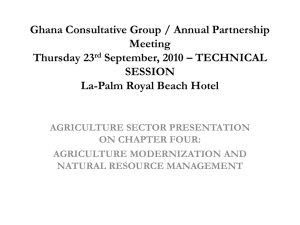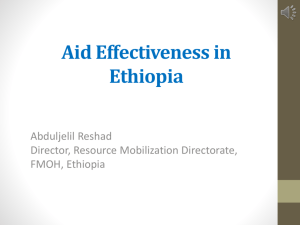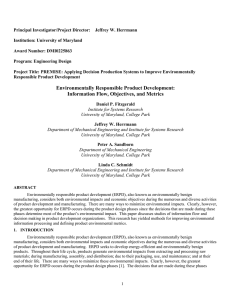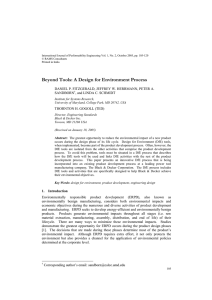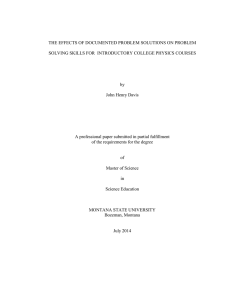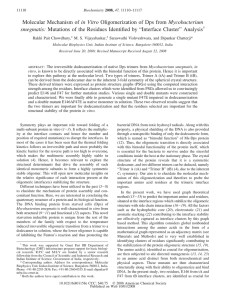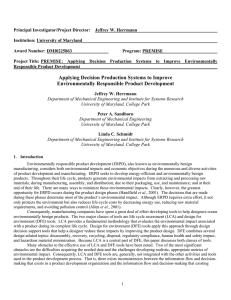Improving Decision-Making for Environmentally Responsible Product Development Problem Situation A Systems Approach
advertisement
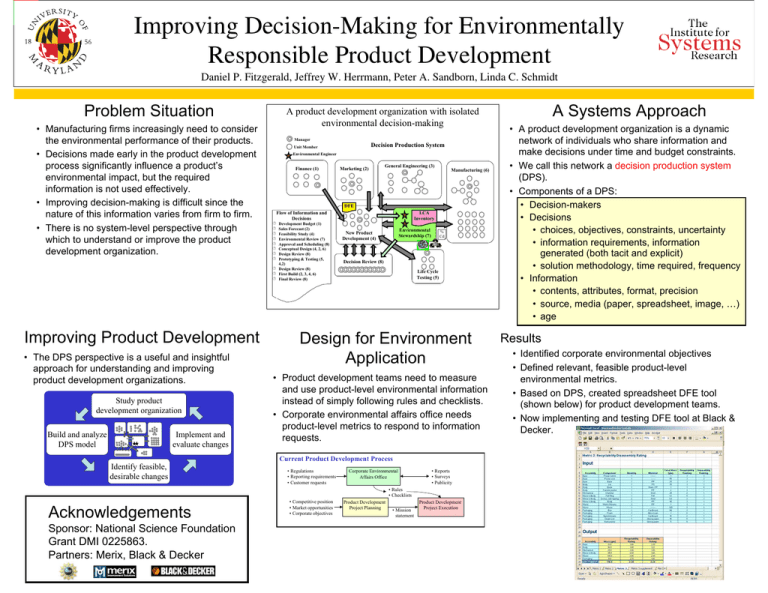
Improving Decision-Making for Environmentally Responsible Product Development Daniel P. Fitzgerald, Jeffrey W. Herrmann, Peter A. Sandborn, Linda C. Schmidt Problem Situation • Manufacturing firms increasingly need to consider the environmental performance of their products. • Decisions made early in the product development process significantly influence a product’s environmental impact, but the required information is not used effectively. • Improving decision-making is difficult since the nature of this information varies from firm to firm. • There is no system-level perspective through which to understand or improve the product development organization. Improving Product Development • The DPS perspective is a useful and insightful approach for understanding and improving product development organizations. Study product development organization Build and analyze DPS model Implement and evaluate changes A product development organization with isolated environmental decision-making Manager Decision Production System Unit Member Environmental Engineer Finance (1) Marketing (2) General Engineering (3) Manufacturing (6) DFE Flow of Information and Decisions Development Budget (1) Sales Forecast (2) Feasibility Study (4) Environmental Review (7) Approval and Scheduling (8) Conceptual Design (4, 2, 6) Design Review (8) Prototyping & Testing (5, 4,2) Design Review (8) First Build (2, 3, 4, 6) Final Review (8) LCA Inventory Environmental Stewardship (7) New Product Development (4) % Cd Decision Review (8) Life Cycle Testing (5) Design for Environment Application • Product development teams need to measure and use product-level environmental information instead of simply following rules and checklists. • Corporate environmental affairs office needs product-level metrics to respond to information requests. Current Product Development Process Identify feasible, desirable changes • Regulations • Reporting requirements • Customer requests Corporate Environmental Affairs Office • Reports • Surveys • Publicity • Rules • Checklists Acknowledgements Sponsor: National Science Foundation Grant DMI 0225863. Partners: Merix, Black & Decker • Competitive position • Market opportunities • Corporate objectives Product Development Project Planning • Mission statement Product Development Project Execution A Systems Approach • A product development organization is a dynamic network of individuals who share information and make decisions under time and budget constraints. • We call this network a decision production system (DPS). • Components of a DPS: • Decision-makers • Decisions • choices, objectives, constraints, uncertainty • information requirements, information generated (both tacit and explicit) • solution methodology, time required, frequency • Information • contents, attributes, format, precision • source, media (paper, spreadsheet, image, …) • age Results • Identified corporate environmental objectives • Defined relevant, feasible product-level environmental metrics. • Based on DPS, created spreadsheet DFE tool (shown below) for product development teams. • Now implementing and testing DFE tool at Black & Decker.

